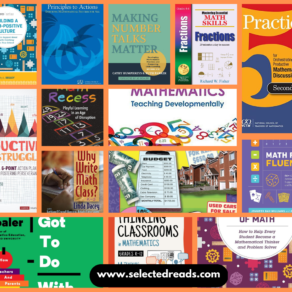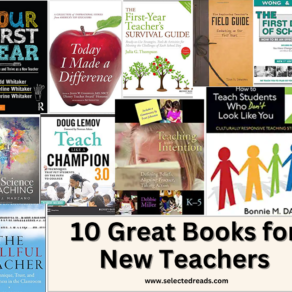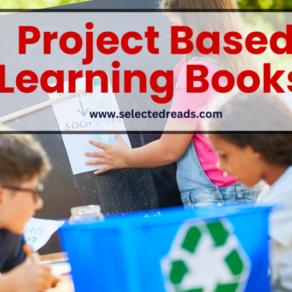Immerse yourself in the vibrant world of art education with this curated compilation. As an art teacher, you are not only a craftsman but also a visionary, bridging the gap between the enigmatic art realm and young, eager minds. In such a fluid, dynamic discipline, it’s natural to feel overwhelmed by the evolving trends, avant-garde techniques, and emerging theories that redefine what art means and how it is taught.
Navigating the labyrinth of resources available can be as intricate as the subject itself, leaving you uncertain about which publications hold the quintessence of knowledge you seek. Worry no more. I have explored the deepest corridors of this maze, hand-picking the gems that can illuminate your teaching journey.
This list is an oasis of wisdom for art teachers. It spans across the eloquent insights of John Berger’s ‘Ways of Seeing’ to the enriching accounts in Danny Gregory’s ‘An Illustrated Life.’ These art books unveil the enigmas behind how celebrated artists breathe life into their masterpieces while sharing hands-on guidance on fostering creativity in children. These guides are not just for seasoned veterans but also aspiring art teachers, hoping to enrich their pedagogical arsenal.
Table of Contents
1. Classroom Management for Art, Music, and PE Teachers,
Classroom Management for Art, Music, and PE Teachers, by Michael Linsin, is a comprehensive resource for teachers who need to manage difficult students in their classes. The book provides practical strategies and tools for classroom management that can help any teacher take control of their classroom, no matter how out of control or unruly it may be.
It offers tips on how to deal with challenging student behaviors, as well as advice on setting expectations and rules. Linsin’s book also includes ideas for reinforcing positive behavior, creating a safe learning environment, and communicating effectively with students of all ages.
2. Art & Fear: Observations On the Perils (and Rewards) of Artmaking
Art & Fear: Observations On the Perils (and Rewards) of Artmaking, by David Bayles and Ted Orland is a book that explores the challenges and rewards of making art. It dives into the world of art and provides an in-depth view into how art is made and experienced by artists.
The book has become an underground classic, having sold 80,000 copies since its original Capra Press publication in 1994. In addition to receiving critical acclaim, Art & Fear has attracted an incredibly diverse audience ranging from beginning to accomplished artists across all mediums, as well as teachers and students.
This is a book written by two working artists who understand the struggles of making art and provide honest, insightful advice to those in similar situations. Whether you’re a beginner just starting out or an experienced artist looking for some new inspiration, Art & Fear will help you on your journey in the world of art making.
3. Teaching with Love & Logic: Taking Control of the Classroom
Teaching with Love & Logic: Taking Control of the Classroom, by Jim Fay and David Funk, offers effective strategies on how to manage classroom dynamics and maximize learning time. This book provides teachers with the skills they need to respond to challenging classroom situations that are not addressed in traditional training. The authors promote a positive approach based on Love & Logic and explain the psychological reasons behind its success in the educational setting.
This guide will help teachers create a positive, supportive environment for their students. With their time-tested ideas and strategies, Fay and Funk show teachers how to use Love & Logic to foster trust between themselves and their students—as well as among each other—and build an atmosphere of mutual respect in the classroom.
4. You Are an Artist: Assignments to Spark Creation
You Are an Artist: Assignments to Spark Creation, by Sarah Urist Green, is an inspiring journey of creation for all artists. The book contains over 50 assignments gathered from some of the most innovative creators working today, and provides techniques and insight from art history to help guide readers in making art.
With only materials that can be sourced for free, readers will feel empowered to take on their own creative projects. From inventing imaginary friends to declaring a cause, this book encourages readers of all experience levels to create meaningful work that reflects their own perspectives and the world around them.
5. The Story of Art
The Story of Art by E.H. Gombrich is a world-renowned classic that has been captivating readers for over four decades. This recently redesigned edition features color illustrations, fold-outs, updated text, new artists, expanded and updated bibliographies, redrawn maps and charts – making this timeless work even more enjoyable for readers of all ages.
This edition has kept the beloved features from previous versions: a pleasure to read and handle with illustrations always where the reader needs them and text running as smoothly as ever.
6. Engaging Learners Through Artmaking: Choice-Based Art Education in the Classroom
Engaging Learners Through Artmaking: Choice-Based Art Education in the Classroom, by Katherine M. Douglas and Diane B. Jaquith, is an updated and revised version of a bestseller that provides teachers with strategies to facilitate independent learning and allow students to make choices regarding subject matter and media.
It includes recommendations on assessments, strategies, classroom setups and media exploration, as well as sample lesson plans and demonstrations. The Second Edition also covers curricular mapping and room planning for kindergarten to grade 8 classrooms.
Featuring multiple perspectives on teaching for artistic behavior, Engaging Learners Through Artmaking is an invaluable resource for art teachers new to choice-based authentic education as well as experienced educators.
7. The Art Teacher’s Survival Guide for Secondary Schools: Grades 7-12
The Art Teacher’s Survival Guide for Secondary Schools: Grades 7-12, by Helen D. Hume is an authoritative and comprehensive guidebook for art teachers. It provides detailed instructions on how to create effective art lessons that encompass fundamentals, digital media and digital photography.
The book includes 75 fun and creative art projects, as well as reproducible handouts, illustrations and photographs. It also features easy-to-follow instructions to help art teachers, secondary classroom teachers and homeschoolers plan effective lessons for their students. Additionally, the book is fully updated with the latest technological changes in the field of art instruction.
8. Art Is Fundamental: Teaching the Elements and Principles of Art in Elementary School
Art Is Fundamental provides an interdisciplinary art curriculum for elementary school classrooms. The comprehensive program covers various printmaking techniques, tessellations, watercolors, calligraphic lines, organic form sculptures, and value collages to teach students the elements and principles of art.
Each lesson builds on prior skills and introduces new concepts in an engaging, interactive way. Lesson plans are designed to help students understand texture, color, shape, line, form, and value as well as balance (formal, informal, and radial), unity, contrast, movement distortion, emphasis pattern and rhythm.
9. Make Your Art No Matter What: Moving Beyond Creative Hurdles
In Make Your Art No Matter What: Moving Beyond Creative Hurdles, Beth Pickens offers practical guidance for developing a lasting and meaningful artistic practice. She aims to help artists confront challenges such as making decisions about time, money, and education; managing emotions like fear, anxiety, and isolation; and finding ways to remain productive even when life gets in the way.
Through concrete examples and actionable advice, she encourages readers to keep going and make their art no matter what. This book is a must-read for any artist looking to break through creative blocks, stay motivated, and continue creating even in the face of life’s obstacles.
10. Girl in Hyacinth Blue
Girl in Hyacinth Blue is a novel by Susan Vreeland that follows the story of a mysterious painting, believed to be an original Vermeer. The painting, which has been kept secret for decades, moves through various owners throughout its history and reveals secrets, triumphs and tragedies of each character’s life.
The protagonist is a professor who invites a colleague from the art department to his home to witness this mysterious masterpiece. As the novel progresses, readers are taken on a journey through history and discover how the painting was inspired and why it has been kept hidden for so long.
11. How to Teach Art to Children
How to Teach Art to Children is an essential guide for introducing children to the world of art. The book provides background information on the seven elements of art – line, shape, color, value, texture, form and space – as well as literature resources and step-by-step instructions for 96 art projects. Children will learn how to use the elements of art, while exploring the techniques employed by famous artists.
12. An Illustrated Life
An Illustrated Life, by Danny Gregory, is an inspiring peek into the creative minds of 50 of the world’s top illustrators, designers and artists. Through interviews with the featured artists, author Danny Gregory provides insight into how they use sketchbooks to capture their ideas and record the world as they see it. The book contains sketches and captions from artists such as R. Crumb, Chris Ware and James Jean, among others.
13. Ways of Seeing
John Berger’s book Ways of Seeing, based on the acclaimed BBC television series of the same name, has become one of the most widely-read and influential books on art in any language. First published in 1972, it offered a unique perspective on how to look at paintings by encouraging readers to think more deeply about what they see and how their own experiences can shape the meaning of an artwork.
14. The Art Teacher’s Book of Lists
The Art Teacher’s Book of Lists is an invaluable resource for art teachers. It features information on the world of art, artists, and art movements from a diverse range of cultures including Africa, Asia, Native America and beyond.
It also provides insights on contemporary artists, artwork, art movements, museum holdings, art websites and more. Topics covered in the book include architecture, drawing, painting, graphic arts, photography and digital arts.





